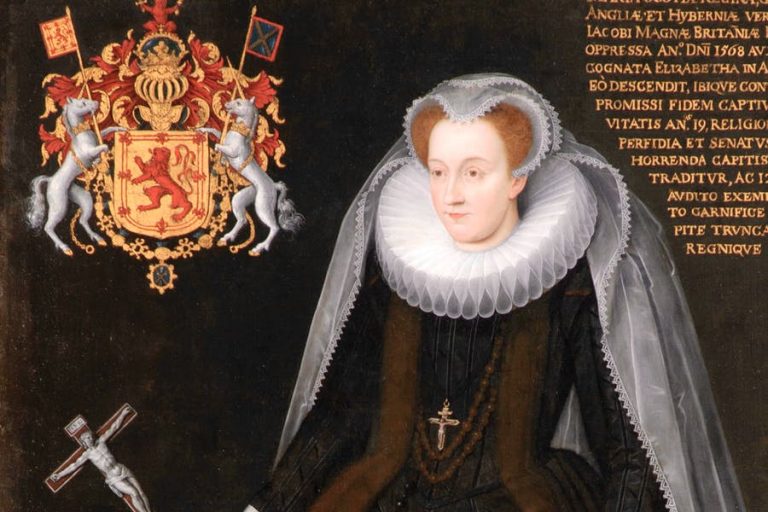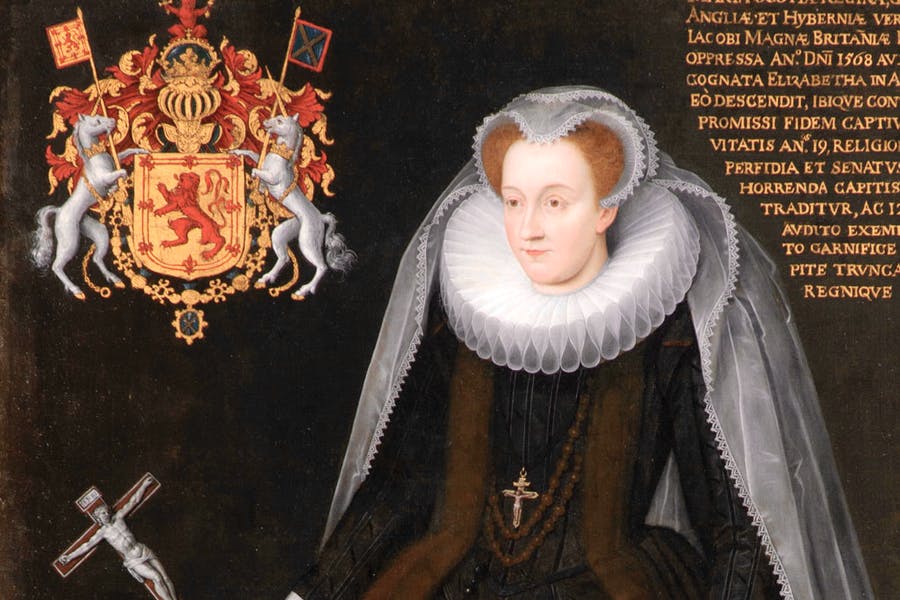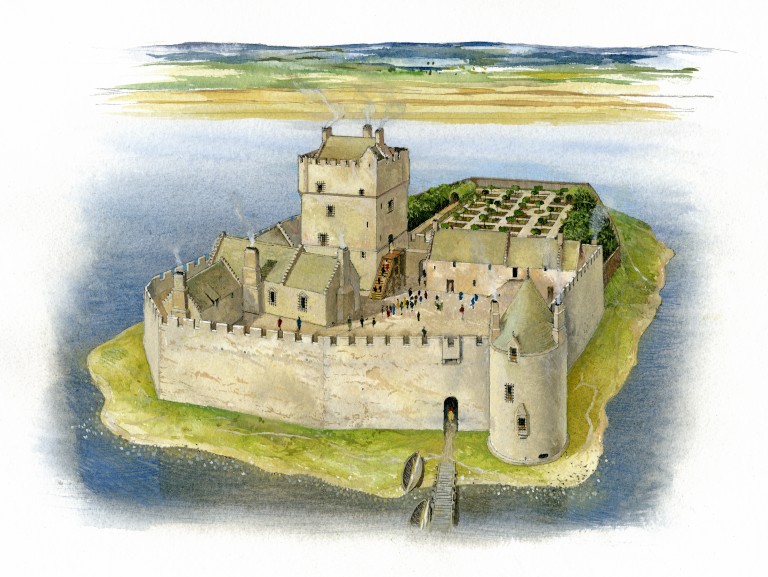
 After 19 years of imprisonment, Mary, Queen of Scots was beheaded at Fotheringhay Castle in England on February 08, 1587 for her complicity in a plot to murder Queen Elizabeth I.
After 19 years of imprisonment, Mary, Queen of Scots was beheaded at Fotheringhay Castle in England on February 08, 1587 for her complicity in a plot to murder Queen Elizabeth I.
Queen Elizabeth I of England and Mary, Queen of Scots were two of the greatest, most legendary rivals in recorded history—although they never even met. In one castle was Elizabeth, the childless “virgin” queen: bawdy, brilliant, tactical and cynical. In the other, Mary: feminine, charming, romantic and reckless.
In 1542, while just six days old, Mary ascended to the Scottish throne upon the death of her father, King James V. Her mother sent her to be raised in the French court, and in 1558 she married the French dauphin, who became King Francis II of France in 1559 but died the following year. After Francis’ death, Mary returned to Scotland to assume her designated role as the country’s monarch.
In 1565, she married her English cousin Lord Darnley in order to reinforce her claim of succession to the English throne after Elizabeth’s death. In 1567, Darnley was mysteriously killed in an explosion at Kirk o’ Field, and Mary’s lover, the Earl of Bothwell, was the key suspect. Although Bothwell was acquitted of the charge, his marriage to Mary in the same year enraged the nobility. Mary brought an army against the nobles, but was defeated and imprisoned at Lochleven, Scotland, and forced to abdicate in favor of her son by Darnley, James.
In 1568, Mary escaped from captivity and raised a substantial army but was defeated and fled to England. Queen Elizabeth initially welcomed Mary but was soon forced to put her friend under house arrest after Mary became the focus of various English Catholic and Spanish plots to overthrow Elizabeth. Nineteen years later, in 1586, a major plot to murder Elizabeth was reported, and Mary was brought to trial. She was convicted for complicity and sentenced to death.
On February 8, 1587, Mary Queen of Scots was beheaded for treason. Her son, King James VI of Scotland, calmly accepted his mother’s execution, and upon Queen Elizabeth’s death in 1603 he became king of England, Scotland and Ireland.
Letters that helped to bring down Queen Mary
In 1567, a tempestuous, unhappy queen picked up her pen and wrote a passionate sonnet to her lover. “My love for him is not an empty show,” she wrote, “But purest tenderness and constancy.”
Or did she?
The sonnet was one of 12. And those documents were part of a larger hoard called the casket letters, explosive papers that played a part in the bizarre story of the tragic end of Mary, Queen of Scots’ marriage to her second husband, the chaotic beginning of a new union, and the events that would cause the Scottish throne to slip through her fingers.
But though the casket letters would be used against Mary, their authenticity have always been in question. Were the letters really penned by Mary Stuart? Or were they the fabrication of the enemies determined to tear down her rule and even have her killed?

Mary Stuart had technically been queen of Scotland since she was six days old. But her grip on the Scottish throne had always been threatened by her political enemies, many of whom resented the Catholic queen.
The most serious threat to her rule broke out in 1567 with the murder of her second husband, Henry Stuart, Lord Darnley. He had been recuperating from smallpox when the house in which he was staying was bombed. Later, it was found that barrels full of gunpowder had been hidden beneath his bedroom. But the bombs didn’t seem to be what killed Lord Darnley. Rather, he appeared to have been strangled.
Lord Darnley’s bizarre death was interpreted as evidence of a plot to kill him, and suspicion soon turned toward Mary herself. It had been common knowledge that she didn’t love her husband, had been appalled by his arrogance and carousing, and had differed with him about matters political and personal. He had also infuriated her by attempting to rule equally alongside her. In 1566, when she was four months pregnant, Darnley had worked with a group of anti-Mary conspirators to murder her friend and private secretary, David Rizzio, in front of her. The assassination had been the last straw. She convened a meeting of advisers to figure out how to divorce her husband.
But did she conspire to murder him?
Mary’s cousin Elizabeth I, queen of England, apparently wondered as much. After the murders, she wrote a sympathetic letter to Mary (the cousins never met in person). But it also contained a word of warning. “I will not at all dissemble what most people are talking about,” she wrote, “which is that you will look through your fingers at the revenging of this deed.” By failing to avenge her husband’s death, Elizabeth suggested, Mary was keeping the rumor mill alive and implicating herself in the deed.

Mary ignored her cousin, and quickly remarried one of her advisers, James Hepburn, 4th Earl of Bothwell. It was unclear whether she married him willingly; it was rumored that he had raped her and forced her into the marriage. Either way, the union horrified Mary’s subjects, who called him a murderer and assumed she had been unfaithful to Darnley. A group of Scottish lords raised an army and forced Mary to abdicate in favor of her one-year-old son with Darnley.
Mary had one ally left—or so she thought. She fled to England with Bothwell and begged in letters for her cousin Elizabeth’s support and help regaining her throne. Instead, worried that Mary wanted to overthrow her, Elizabeth had her imprisoned. Then, she insisted on determining if Mary was guilty of both murder and adultery. But Elizabeth knew that one queen couldn’t get away with impugning another, so she convened not a trial, but a 1568 conference in which the English Privy Council, Elizabeth’s closest advisers, would consider Mary’s actions.
And that’s where the casket letters—eight letters, two marriage contracts, and 12 sonnets—come in. They had supposedly been found in a silver casket among Mary’s possession after she fled Scotland, and the implications for Mary’s monarchy were scandalous. If they were true, that is.
The contents of the caskets were salacious and explosive. The marriage contracts included a promise on Mary’s part to marry Bothwell and a contract signed over a month before Darnley’s death. The sonnets, supposedly written by Mary, painted her as a passionate and faithful lover trying to seduce and convince her secret love. And the letters supposedly showed the lovers conspiring to kill Darnley and create a sham abduction by Bothwell that resulted in their marriage.
There were serious holes in the argument that the casket letters were genuine. First, they had been produced by James Stuart, Earl of Moray, Mary’s half-brother and longtime political foe. Second, they were not signed, addressed, or dated. The facts they supposedly presented were also inconsistent. But when the council compared the handwriting to Mary’s, they determined that they were authentic.
It’s hard to determine whether that’s true today, since the letters have been lost. Using copies and passed-down transcriptions of the letters, historians now speculate that the letters were a mix of fact and fiction that combined Mary’s actual writings with false dates, additional information, and misdirection. Historian John Guy believes that about half of the information in the letters is false. “The Casket Letters were a fix by Mary’s enemies to destroy her, an ingenious, devious one,” he writes. Others argue that they were pure forgeries.
Elizabeth’s council apparently believed the information in the letters, but Mary never defended herself in front of them. Since she considered herself to still be Queen of Scots, she couldn’t publicly acknowledge that an English court or council had any power over her. Nor did Elizabeth take the opportunity to find her cousin guilty of anything. Instead, she considered the evidence gathered by her council and decided that nothing had been proven.
The public, though, had come to its own conclusions. It got access to the casket letters through an unauthorized leak in 1571. A detection of the actions of Mary Queen of Scots concerning the murder of her husband, and her conspiracy, adultery, and pretended marriage with the Earl Bothwell and a defence of the true Lords, maintainers of the King’s Majesties action and authority offered titillating reading, but they served a bigger purpose.
By that point, Mary had been in Elizabeth’s custody—locked up in a palace, but locked up all the same—for over a decade. But her allies still plotted to help her take over Elizabeth’s throne. The letters were published to undermine public opinion in someone that, without the help of sensational claims about her evil ambitions, might have been regarded as a pitiful monarch whose throne had been stolen and who had served years of unfair imprisonment. True or not, the casket letters still had the potential to hurt Mary.
Ultimately, Mary was imprisoned for nearly 19 years before being found guilty of a plot to assassinate Elizabeth and assume her throne. She was beheaded in 1587. By then, her letters had disappeared. The casket, though, is still in existence. It’s kept at Lennoxlove, a Scottish castle, along with a death mask of the queen whose loose letters may have sealed her fate.
______________________
